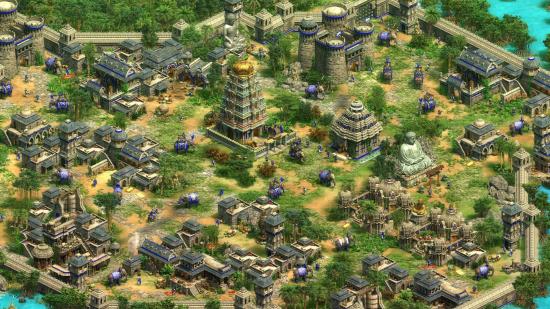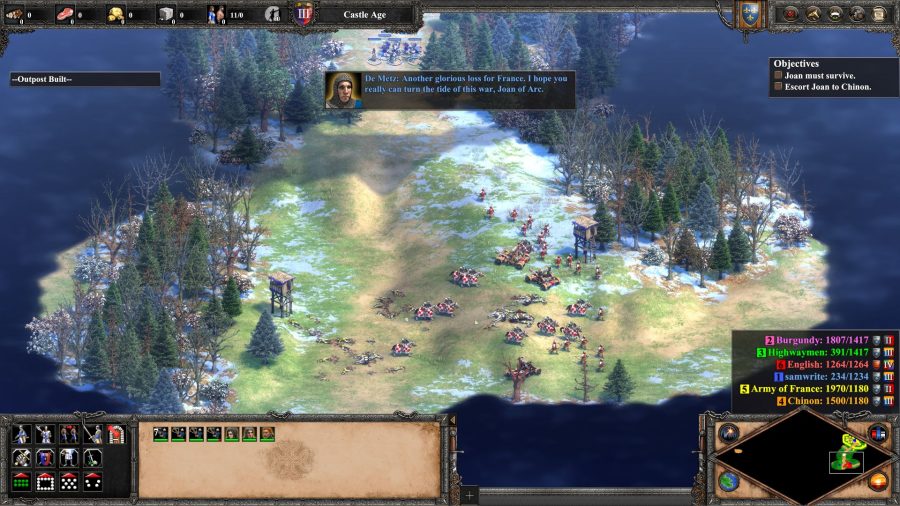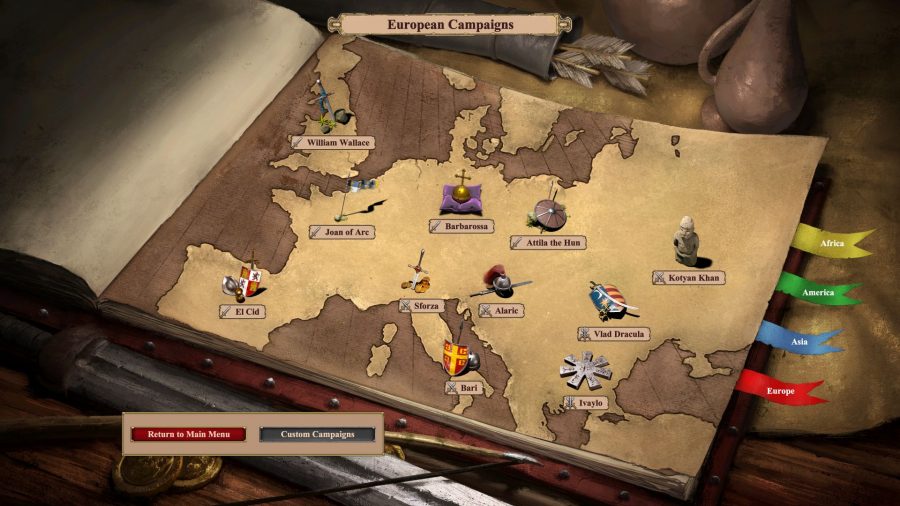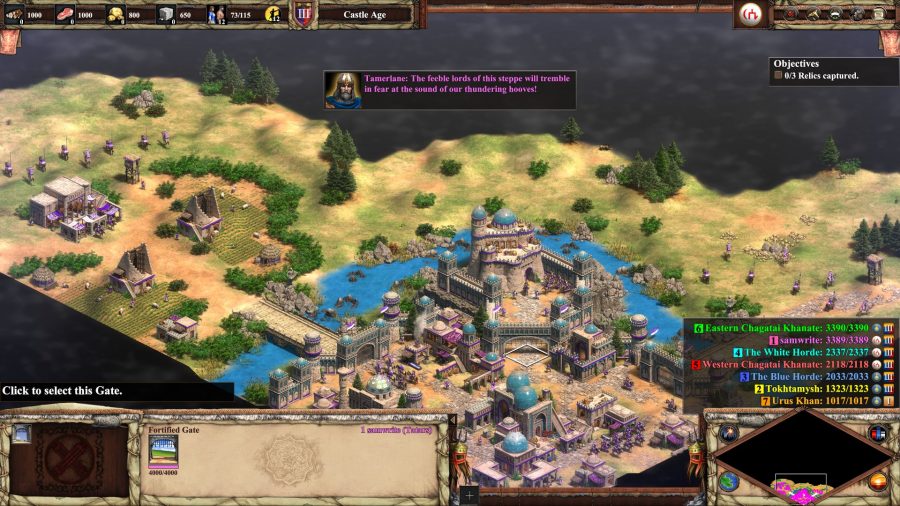Our Verdict
With new official DLC, a glorious audiovisual overhaul and a touch of modern quality-of-life polish, this is now the best way to play Age 2 - though it'll take a while to match the HD edition's user content.
Ahhhhhh, Age of Empires. Is there any early millenium gaming nostalgia stronger than the memories of playing this series? Sat at a tiny hand-me-down CRT deeper than it is wide; the dawn sunrise outside, volume turned all the way down to avoid waking the family, sipping a coca cola to keep yourself awake.
For teenage me, definitely not.
Yet the Definitive Edition of Age of Empires II is a bit of a weird one. After all, we already have an HD edition of the 1999 original, which, while initially received with scepticism, has since won a keen community after years of official support and user-generated content. This raises the question of what exactly this new release can do to win over said community and earn the big-D moniker. It turns out the answer basically boils down to two things. Firstly, lots of content (20 years’ worth!), including some all-new campaign missions and four all-new civilisations for this edition in the Last Khans pack – Bulgarians, Cumans, Lithuanians, and Tatars. And the big clincher: all of it is presented very well for modern audiences, with updated looks and a few refined mechanics.
The new 4K visuals pack gives the game not so much a lick of paint as a whole new coat – it very much shines in that regard, and I think it’s as close as it could possibly be to how I remember it being all those years ago in my cramped bedroom setup. Will it entice new audiences to the franchise? I think it’s definitely still catering for the hardcore, well-versed RTS crowd looking to take a strategic stroll down real-time memory lane. Don’t expect it to play entirely like a modern game, and don’t judge it for not doing so. That’s not the point.

Buildings and troops look brilliant, and the ability to zoom in and out gives you ample opportunity to admire the artwork. Lighting too is great, letting snow-flocked trees and burning pyres really pop. Overall it’s much better than the lacklustre halfway house of the HD edition, at least where graphics are concerned.
Then there’s the reworked audio and voice work, both of which add another dimension of immersion – this game is ultimately an exercise in the bloody history of medieval warfare from the west of Europe to the east of Asia, and having some gruff soldiers giving pre-battle context (I particularly love the Scots’ narration) is much appreciated. It’s definitely got an overtly dry tone, that much is obvious by today’s perspective, but to me that’s part of the charm.
Developer Forgotten Empires jams a lot of other stuff into this package to make it pretty appealing to anyone that’s pining to revisit a classic. Providing, that is, you can appreciate that there’s no way to fully polish a two-decade old game to modern standards. The press release tells me there’s over 200 hours of gameplay here, but to be honest I think that’s quite conservative. Consider the 27 single-player campaigns, the online multiplayer, and the endless player-created content that’s sure to follow if this game wins an audience of any size at all, and you could definitely go north of that should you wish to fully indulge.
The campaigns are good fun, and still offer a lot of variety in terms of gameplay dynamics from chapter to chapter. In one you’re escorting Joan of Arc through a battle-ridden forest, avoiding other armies fighting. In another, one of the new campaigns from The Last Khans, you’re attempting to unite different factions in tundric plains without letting your leader perish. In another, you’re trying to capture relics from rival Transoxianan khanates (whatever those are). The fundamentals of gathering resources, training troops and villagers, and attempting to destroy enemies, build wonders, and steal relics are all intact throughout, but the variation in objectives keeps things interesting.
There are also new Challenge Missions that channel Sun-Tzu’s ‘The Art of War’ and get you completing specific gauntlets. These are basically advanced tutorials intended to teach high-level plays and strategies, which I found especially helpful having been away from the genre for a while and which those intent on getting into multiplayer will appreciate, but they’re also really enjoyable in their own right.
The game is unavoidably archaic in some ways (looking at you specifically, user interface). For one, it’s still frequently impossible to discern different units, especially in larger battles. Micromanagement is also essential, and not always in a fun way, because of the retained lack of some options like an auto-explore on your scouts. This means you literally can’t stop thinking about the game for a second (don’t forget to pause!) and the pacing is sometimes borderline stressful because of this.
That said, Forgotten Empires does offer some quality of life improvements to smooth away some of those ’90s rough edges. Villager micromanagement has been dramatically reduced, thanks to the ability to queue building construction and set farms to automatically re-seed. The game will also automatically filter out villagers when drag-selecting soldiers, so you’re no longer sending civilians off to besiege castles. Animations and AI have both been improved, too, the latter of which now allows muti-tasking which makes a big difference, even if that doesn’t entirely mask the two decades of progression that this genre has seen.
In terms of the aforementioned tweaks to AI, I’ve never been the greatest strategy mastermind (the pacifist in me finds more therapeutic joy in building a city than outsmarting a computer-controlled opponent with rubber band advantages) but there was never the sense that I’m dealing with opposition that was coded in 1999.
Forgotten Empires and Microsoft have made much of the updated AI for the Definitive Edition – which can apparently imitate the strategies of real-life tournament players – and let’s not forget that they’re building on the 2013 HD edition and its years of support. If you want, you can still select the classic 1999 AI, which like many strategy opponents of the time had to be coded to literallty cheat to win against players, but the updated systems are much more realistic and satisfying to play against.
No amount of rehashing graphics or tweaking root code will ever fully reclaim the sense of wonder of playing this game two decades ago. But, if Forgotten Empires’ two objectives were what I suspect – to do the game the presentational justice it deserves, and to package this game’s nostalgia in one place – then I think Definitive Edition wholly succeeds. It’s not Age of Empires IV, but it’s a great step toward the full return of one of PC’s most iconic franchises.



